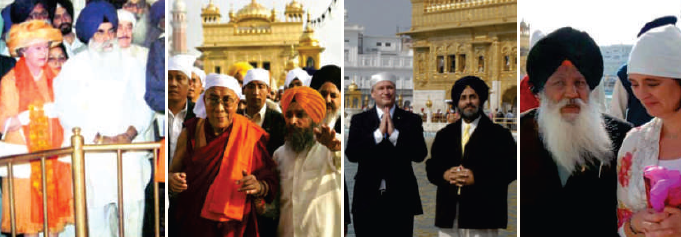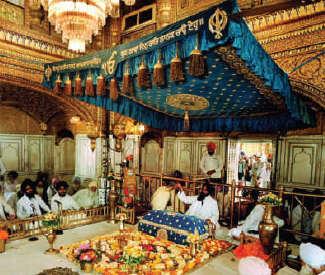Harmandir Sahib (The Golden Temple), Amritsar
This is a collection of articles archived for the excellence of their content. |
Harmandir Sahib (The Golden Temple)
by Patwant Singh
A Day at Darbar Sahib
India Harmony Volume - 1 : Issue - 2, 2013
For thousands of Amritsar's inhabitants, the day begins early. It begins, in fact, the night before at three o'clock or so in the morning, as householders in the city stir with the activity of people preparing for a predawn visit to Darbar Sahib - a routine that hasn't changed for four centuries.
The devout of Amritsar eagerly await this hour each morning with the keen sense of anticipation that comes from knowing they will soon visit the Harimandir.
As they walk through the familiar streets of the old city, their pace quickens in expectation of soon seeing the beloved shrine. Some of them have made this walk at this hour each morning for as long as they can remember.
Outside the main entrance, they take their shoes off, checks them with an attendant and proceed, ... to the complex. At a trough of swiftly running water, they dip their feet to cleanse them. As they pass the flowers stall, some stop to buy garlands of yellow, gold or russet marigolds to carry inside as offerings.
Descending the marble stairs to the parkarma, they behold in the center of the sarowar, the serene and immortal Harimandir Sahib. They gaze at it with awe and with reverence and love the very emotions others before them have experienced for as long as the Harimandir has existed. They are transfixed by this first sight of it by its golden facades and domes. The waters around it are still and glassy in the peaceful early morning silence, and capture an almost perfect reflection.
Bowing low to make their foreheads touch the cool marble of the parkarma, worshippers pay homage and express thanks for the divine grace that has made their visit possible. Then, as is customary, they turn left to go around the entire parkarma, and to stop at shrines on the way, before finally reaching the Harimandir.
The first shrine along the marble walkway is Dukh Bhanjani Ber. Built around a dujube tree, it marks the spot there, it is said, a dip in the sacred pool miraculously cured a crippled youth. Since many consider their visit to the temple incomplete without bathing at this spot here and enter the water, hoping to shed their afflictions and troubles.
Past Dukh Bhanjani Ber is a raised marble platform which is the Ath Sath Tirath, the Shrine of the Sixty eight Holy Places. If they bathe near it, some believe, their dreams of visiting the 68 holy places of India will be fulfilled. Further along the parkarma, around the next corner is the shrine of Baba Deep Singh, the legendary old warrior who died at this spot. Ever since pilgrims have paused here to pray to sprinkle rose petals or to lay fresh garlands in his honor.
Such cameos of valor enliven the rich mosaic of a military tradition that continues to this day. Even now, the names of Sikh martyrs and soldiers who die in battle are inscribed on marble plaques embedded in the floor of the parkarma or on the pillars of the adjoining verandahs. Many Indian Army regiments still maintain the tradition of installing commemorative plaques here to honor their war heroes.
As the devout turn the next corner of the parkarma, leading to Akal Takht and Darshani Deorhi, their excitement builds, for soon they will witness, and possibly join in the ceremonies that only those who visit Darbar Sahib at this hour can. These are the rituals that attend the traditional bearing of Guru Granth Sahib from Katha Sahib at Akal Takht where it is kept each night, to Harimandir Sahib, to which it is always returned before five o'clock in the morning.
About half and hour before Granth Sahib is brought down from Akal Takth, the palki, a gold and silver palanquin, is prepared for it. Attendants replace the cushions and pillows on which Granth Sahib will rest. They lay down fresh sets of silk and brocade coverings and, when everything is ready, they sprinkle delicately scented rose water over all.
As the head priest of the Harimandir appears with Granth Sahib on a cushion on his head, a series of deep, resonant drum beats of the nagara heralds its arrival to the assembled worshippers who, even at this hour, fill the large plaza to capacity.
Showering fragrant red, pink and white rose petals, and reciting hymns from the holy scriptures, they make way for the palki's journey to the Harimandir. This passage, through short, sometimes takes up to half an hour while as many worshippers as possible share the honor of carrying it.
The procession solemnly moves across the plaza through Darshani Deorhi, and along the causeway, stopping as it reaches the main door of the Harimandir. The head priest reverently lifts Granth Sahib out of the palke, places it on a silk cushion on his head and enters the holy shrine.
He carries it to its customary place of honor beneath a velvet canopy richly brocaded with silver and gold, and carefully sets it on velvet cushions and silks placed on Manji Sahib.
As the congregation stands in hushed silence, the head priest seats himself in front of Guru Granth Sahib, ceremoniously opens it, and reads aloud the 'Vaq', or the Lord's message, for the day. The recitation of 'Asa di War', which had been in progress here since a little after 3 a.m., had stopped as Granth Sahib was carried in, sung always at this pre-dawn hour, Asa di War also, like all other compositions recited here, is taken from Granth Sahib.
After the 'Vaq' is read, the singing of 'Asa di War' continues. As it ends, the entire congregation and the servitors of the temple stand up for the Ardas, a prayer that is recited at the conclusion of each service. After the Ardas, the Shabad Kirtan, the vocal and musical rendition of sacred verses, is resumed. Shabads will be sung throughout the day and late into the evening by a succession of ragis. The early morning worshippers now step out of the Harmandir, walk on the inner parkarma that encircles it, and stop on its southern side at the Har ki Pauri. Here, marble steps descend into the sarowar so that visitors may cup the water of the sacred pool in their hands and sprinkle it on their heads. Some take a small sip of it as well. Tradition has it that Guru Arjan himself gave this place its name.
Continuing around the Harmandir, on the inner parkarma, the devotees once more bow in the direction of Granth Sahib, then make their way back over the causeway, through Darshani Deorhi and on to the main parkarma.
As they proceed along the parkarma, towards the stairs by which they had entered, some pause by Ber Baba Buddha, popularly represented, from those who have already made the better part of their journey through life, to the newlyweds who have come to seek blessings for the life that lies ahead - brides in scarlet and gold wedding finery, grooms in crisply tied pink or red turbans.
People are spread out everywhere. Some are in the Harmandir listening to the Shabad kirtan on the ground floor, others are absorbed in the words of the akhand path in the quiet of its upper floors. Some visit Akal Takht where the swords and personal weapons of Guru Gobind Singh are enshrined.
Many join the line in front of the special kitchen where Karah parshad is prepared. They make a donation of money for this sacramental food and carry it into the Harimandir. They give it to the attendants stationed at the door specially to receive it. The attendants, in turn pass it on with Got's blessing to those leaving the sanctum. Some devotees sit in quiet contemplation in the Shrine of Baba Atal, built to honor Guru Hargobind's remarkably gifted son who died young or in the shrine built in Guru Tegh Bahadur's memory. Since voluntary service is the very essence of Sikhism, a continuous stream of visitors makes its way to the Guru Ram Dass langar, to help prepare the food that will be served to the thousands who eat there daily.
Occasionally visitors go on brief forays into the winding bazaars around Darbar Sahib, drawn to them by the endless variety of goods on display, the prospect of good-natured bargaining, the banter between the customers and the shopkeepers, and the stimulation of the many colors, textures and sounds that only a traditional Indian bazaar offers.
As the sun sets and the time for evening prayers nears, there is a perceptible change in the nature of the people who now enter the Harimandir. These devotees come to sit and listen in rapt attention to the evening recitations, and to enjoy the beauty of the verses and the rags in which these prayers are rendered. Just as in the morning prayers began with 'Asa di War', in the evening prayers end with the Rahras, the arti, and the shabad kirtan, concluding with Ardas at 9:45 pm.
When the prayers end, Guru Granth Sahib reverently closed, wrapped in fresh layers of rich silk and muslin, and ceremonially carried to the palki waiting outside. As in the morning, so also now, the palki is shouldered by devout Sikhs and taken to Kotha Sahib where Granth Sahib will rest for the night.
The massive silver and rosewood doors of Darshani Deorhi are shut and a group of volunteers inside the Harimandir start the ritual cleansing of the shrine with milk and water in preparation for the next day. In the few hours the doors of Darshani Deorhi will once again be opened to worshippers, and the Harmindir will be ready to receive them so that they can welcome the arrival of Guru Granth Sahib and seek spiritual guidance for another day.
Seeing the glow of the lamps and their myriad reflections in the pool, bearing the melodic chanting of hymns, tossing handfuls of rose petals before the procession of Granth Sahib, and feeling the intensity of the love and reverence that attend each ritual are experiences that will always be remembered.
Day after day, the Harimandir, the abiding symbol of the Sikh faith, continues to inspire and uplift those thousands who come to it. It is, in a sense, the heart of the Sikh, for wherever beats a Sikh heart, there throbs the sentiment of undying devotion for this holiest of all Sikh shrines.




